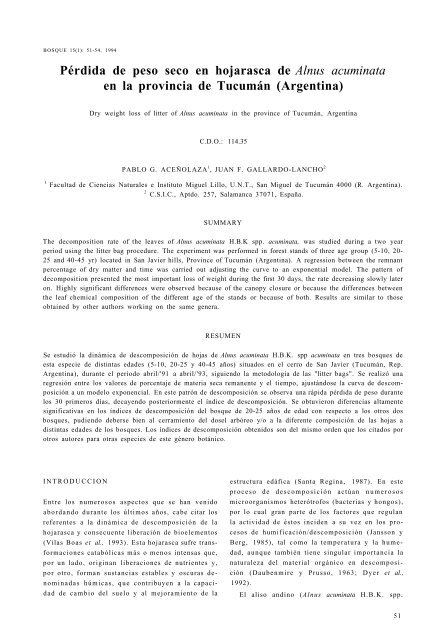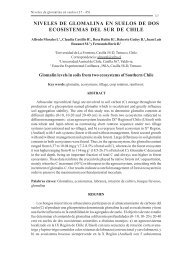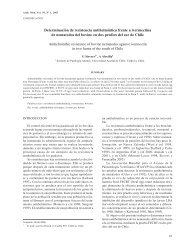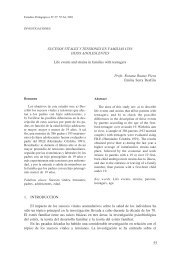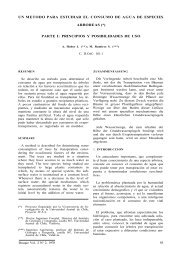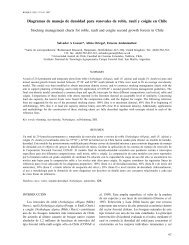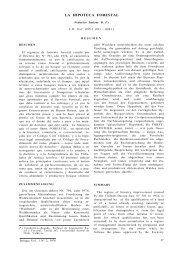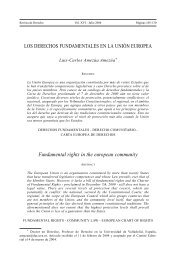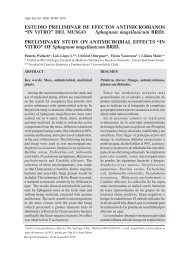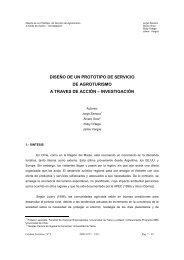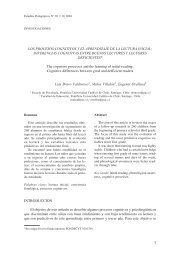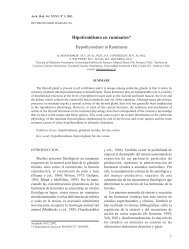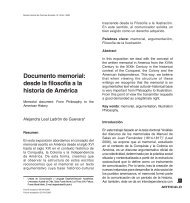Pérdida de peso seco en hojarasca de Alnus acuminata en la ...
Pérdida de peso seco en hojarasca de Alnus acuminata en la ...
Pérdida de peso seco en hojarasca de Alnus acuminata en la ...
Create successful ePaper yourself
Turn your PDF publications into a flip-book with our unique Google optimized e-Paper software.
BOSQUE 15(1): 51-54, 1994<br />
<strong>Pérdida</strong> <strong>de</strong> <strong>peso</strong> <strong>seco</strong> <strong>en</strong> <strong>hojarasca</strong> <strong>de</strong> <strong>Alnus</strong> <strong>acuminata</strong><br />
<strong>en</strong> <strong>la</strong> provincia <strong>de</strong> Tucumán (Arg<strong>en</strong>tina)<br />
Dry weight loss of litter of <strong>Alnus</strong> <strong>acuminata</strong> in the province of Tucumán, Arg<strong>en</strong>tina<br />
C.D.O.: 114.35<br />
PABLO G. ACEÑOLAZA 1 , JUAN F. GALLARDO-LANCHO 2<br />
1 Facultad <strong>de</strong> Ci<strong>en</strong>cias Naturales e Instituto Miguel Lillo, U.N.T., San Miguel <strong>de</strong> Tucumán 4000 (R. Arg<strong>en</strong>tina).<br />
2 C.S.I.C., Aptdo. 257, Sa<strong>la</strong>manca 37071, España.<br />
SUMMARY<br />
The <strong>de</strong>composition rate of the leaves of <strong>Alnus</strong> <strong>acuminata</strong> H.B.K spp. <strong>acuminata</strong>, was studied during a two year<br />
period using the litter bag procedure. The experim<strong>en</strong>t was performed in forest stands of three age group (5-10, 20-<br />
25 and 40-45 yr) located in San Javier hills, Province of Tucumán (Arg<strong>en</strong>tina). A regression betwe<strong>en</strong> the remnant<br />
perc<strong>en</strong>tage of dry matter and time was carried out adjusting the curve to an expon<strong>en</strong>tial mo<strong>de</strong>l. The pattern of<br />
<strong>de</strong>composition pres<strong>en</strong>ted the most important loss of weight during the first 30 days, the rate <strong>de</strong>creasing slowly <strong>la</strong>ter<br />
on. Highly significant differ<strong>en</strong>ces were observed because of the canopy closure or because the differ<strong>en</strong>ces betwe<strong>en</strong><br />
the leaf chemical composition of the differ<strong>en</strong>t age of the stands or because of both. Results are simi<strong>la</strong>r to those<br />
obtained by other authors working on the same g<strong>en</strong>era.<br />
RESUMEN<br />
Se estudió <strong>la</strong> dinámica <strong>de</strong> <strong>de</strong>scomposición <strong>de</strong> hojas <strong>de</strong> <strong>Alnus</strong> <strong>acuminata</strong> H.B.K. spp <strong>acuminata</strong> <strong>en</strong> tres bosques <strong>de</strong><br />
esta especie <strong>de</strong> distintas eda<strong>de</strong>s (5-10, 20-25 y 40-45 años) situados <strong>en</strong> el cerro <strong>de</strong> San Javier (Tucumán, Rep.<br />
Arg<strong>en</strong>tina), durante el período abril/'91 a abril/'93, sigui<strong>en</strong>do <strong>la</strong> metodología <strong>de</strong> <strong>la</strong>s "litter bags". Se realizó una<br />
regresión <strong>en</strong>tre los valores <strong>de</strong> porc<strong>en</strong>taje <strong>de</strong> materia seca reman<strong>en</strong>te y el tiempo, ajustándose <strong>la</strong> curva <strong>de</strong> <strong>de</strong>scomposición<br />
a un mo<strong>de</strong>lo expon<strong>en</strong>cial. En este patrón <strong>de</strong> <strong>de</strong>scomposición se observa una rápida pérdida <strong>de</strong> <strong>peso</strong> durante<br />
los 30 primeros días, <strong>de</strong>cay<strong>en</strong>do posteriorm<strong>en</strong>te el índice <strong>de</strong> <strong>de</strong>scomposición. Se obtuvieron difer<strong>en</strong>cias altam<strong>en</strong>te<br />
significativas <strong>en</strong> los índices <strong>de</strong> <strong>de</strong>scomposición <strong>de</strong>l bosque <strong>de</strong> 20-25 años <strong>de</strong> edad con respecto a los otros dos<br />
bosques, pudi<strong>en</strong>do <strong>de</strong>berse bi<strong>en</strong> al cerrami<strong>en</strong>to <strong>de</strong>l dosel arbóreo y/o a <strong>la</strong> difer<strong>en</strong>te composición <strong>de</strong> <strong>la</strong>s hojas a<br />
distintas eda<strong>de</strong>s <strong>de</strong> los bosques. Los índices <strong>de</strong> <strong>de</strong>scomposición obt<strong>en</strong>idos son <strong>de</strong>l mismo or<strong>de</strong>n que los citados por<br />
otros autores para otras especies <strong>de</strong> este género botánico.<br />
INTRODUCCION<br />
Entre los numerosos aspectos que se han v<strong>en</strong>ido<br />
abordando durante los últimos años, cabe citar los<br />
refer<strong>en</strong>tes a <strong>la</strong> dinámica <strong>de</strong> <strong>de</strong>scomposición <strong>de</strong> <strong>la</strong><br />
<strong>hojarasca</strong> y consecu<strong>en</strong>te liberación <strong>de</strong> bioelem<strong>en</strong>tos<br />
(Vi<strong>la</strong>s Boas et al., 1993). Esta <strong>hojarasca</strong> sufre transformaciones<br />
catabólicas más o m<strong>en</strong>os int<strong>en</strong>sas que,<br />
por un <strong>la</strong>do, originan liberaciones <strong>de</strong> nutri<strong>en</strong>tes y,<br />
por otro, forman sustancias estables y oscuras <strong>de</strong>nominadas<br />
húmicas, que contribuy<strong>en</strong> a <strong>la</strong> capacidad<br />
<strong>de</strong> cambio <strong>de</strong>l suelo y al mejorami<strong>en</strong>to <strong>de</strong> <strong>la</strong><br />
estructura edáfica (Santa Regina, 1987). En este<br />
proceso <strong>de</strong> <strong>de</strong>scomposición actúan numerosos<br />
microorganismos heterótrofos (bacterias y hongos),<br />
por lo cual gran parte <strong>de</strong> los factores que regu<strong>la</strong>n<br />
<strong>la</strong> actividad <strong>de</strong> éstos inci<strong>de</strong>n a su vez <strong>en</strong> los procesos<br />
<strong>de</strong> humificación/<strong>de</strong>scomposición (Jansson y<br />
Berg, 1985), tal como <strong>la</strong> temperatura y <strong>la</strong> humedad,<br />
aunque también ti<strong>en</strong>e singu<strong>la</strong>r importancia <strong>la</strong><br />
naturaleza <strong>de</strong>l material orgánico <strong>en</strong> <strong>de</strong>scomposición<br />
(Daub<strong>en</strong>mire y Prusso, 1963; Dyer et al.,<br />
1992).<br />
El aliso andino (<strong>Alnus</strong> <strong>acuminata</strong> H.B.K. spp.<br />
51
PABLO G. ACEÑOLAZA, JUAN F. GALLARDO-LANCHO<br />
<strong>acuminata</strong>) es <strong>la</strong> única especie <strong>de</strong> <strong>la</strong> familia<br />
Betu<strong>la</strong>cea <strong>en</strong> el Hemisferio Sur. En <strong>la</strong> provincia<br />
<strong>de</strong> Tucumán (Arg<strong>en</strong>tina) llega a formar bosques<br />
continuos <strong>en</strong> <strong>la</strong><strong>de</strong>ras húmedas situadas <strong>en</strong>tre los<br />
1.500 y 2.500 m s.n.m. (Aceño<strong>la</strong>za et al., 1992).<br />
Consecu<strong>en</strong>tem<strong>en</strong>te, el objetivo <strong>de</strong>l pres<strong>en</strong>te trabajo<br />
es conocer el índice <strong>de</strong> <strong>de</strong>scomposición <strong>de</strong><br />
<strong>la</strong>s hojas <strong>de</strong> aliso <strong>en</strong> tres bosques <strong>de</strong> difer<strong>en</strong>tes<br />
eda<strong>de</strong>s <strong>de</strong> <strong>la</strong> provincia <strong>de</strong> Tucumán (Rep. Arg<strong>en</strong>tina),<br />
y <strong>la</strong>s re<strong>la</strong>ciones <strong>de</strong> aquel parámetro con los<br />
factores abióticos ambi<strong>en</strong>tales. Por tanto, se <strong>de</strong>sea<br />
establecer si los índices <strong>de</strong> <strong>de</strong>scomposición <strong>de</strong> <strong>la</strong>s<br />
hojas <strong>de</strong> alisos varían con <strong>la</strong> edad <strong>de</strong>l bosque o no;<br />
<strong>de</strong> otra manera, si <strong>la</strong>s condiciones microambi<strong>en</strong>tales,<br />
y/o <strong>la</strong> difer<strong>en</strong>te composición <strong>de</strong> <strong>la</strong> <strong>hojarasca</strong><br />
(si <strong>la</strong> hubiere), causada por el <strong>de</strong>sarrollo <strong>de</strong>l bosque<br />
(aliseda), produce un cambio significativo <strong>en</strong><br />
<strong>la</strong> velocidad <strong>de</strong> <strong>de</strong>scomposición <strong>de</strong> <strong>la</strong> <strong>hojarasca</strong>.<br />
MATERIAL Y METODOS<br />
El pres<strong>en</strong>te estudio se llevó a cabo <strong>en</strong> alisedas <strong>de</strong>l<br />
Parque Biológico <strong>de</strong> <strong>la</strong> Sierra <strong>de</strong> San Javier (reserva<br />
natural <strong>de</strong> <strong>la</strong> Universidad Nacional <strong>de</strong><br />
Tucumán). El clima <strong>de</strong>l área consi<strong>de</strong>rada es húmedo-temp<strong>la</strong>do<br />
(húmedo mesotérmico), que según el<br />
sistema climático <strong>de</strong> Köpp<strong>en</strong> correspon<strong>de</strong> a <strong>la</strong> fórmu<strong>la</strong><br />
Cwb (Aceño<strong>la</strong>za et al., 1992).<br />
Se eligieron tres alisedas <strong>de</strong> difer<strong>en</strong>tes eda<strong>de</strong>s:<br />
una "jov<strong>en</strong>" (5 a 10 años), otra que se <strong>de</strong>nomina<br />
"madura" (20 a 25 años) y una última consi<strong>de</strong>rada<br />
"vieja" (40 a 50 años), procurando que se <strong>en</strong>cu<strong>en</strong>tr<strong>en</strong><br />
cercanas unas a otras y <strong>en</strong> situaciones<br />
geomorfológicas simi<strong>la</strong>res.<br />
Para seguir <strong>la</strong> evolución <strong>de</strong> <strong>la</strong> <strong>de</strong>scomposición<br />
<strong>de</strong> <strong>la</strong>s hojas se confeccionaron bolsas (litter bags)<br />
<strong>en</strong> <strong>la</strong>s que se introdujo un <strong>peso</strong> conocido <strong>de</strong> hojas<br />
<strong>de</strong> aliso; este método ha sido utilizado con éxito<br />
por difer<strong>en</strong>tes investigadores (Bocock et al., 1960;<br />
Edmonds, 1979; Sharma y Ambasht, 1987), t<strong>en</strong>i<strong>en</strong>do<br />
siempre <strong>en</strong> cu<strong>en</strong>ta <strong>la</strong>s limitaciones que el<br />
mismo posee, <strong>en</strong>tre éstas, <strong>la</strong> inaccesibilidad <strong>de</strong> <strong>la</strong><br />
microfauna (Santa Regina 1987; Hernán<strong>de</strong>z et al.,<br />
1992). Las bolsas <strong>de</strong> 18x15 cm se fabricaron con<br />
mal<strong>la</strong> <strong>de</strong> nylon <strong>de</strong> 1 mm <strong>de</strong> luz; <strong>en</strong> cada una <strong>de</strong><br />
el<strong>la</strong>s se introdujeron exactam<strong>en</strong>te 10 g <strong>de</strong> hojas<br />
(<strong>peso</strong> fresco, humedad conocida) <strong>de</strong> aliso cercanas<br />
a <strong>la</strong> abscisión. Se colocaron 50 bolsas bajo los<br />
árboles <strong>en</strong> cada una <strong>de</strong> <strong>la</strong>s alisedas citadas, procurando<br />
que todas <strong>la</strong>s bolsas permanecieran <strong>en</strong> condiciones<br />
ecológicam<strong>en</strong>te semejantes. Durante dos<br />
años se fueron retirando progresivam<strong>en</strong>te 5 bolsas<br />
por bosque, <strong>de</strong>s<strong>de</strong> abril <strong>de</strong> 1991 hasta abril <strong>de</strong><br />
1993 (a los 2, 6, 14, 30, 62, 126, 254 y 715 días<br />
<strong>de</strong>s<strong>de</strong> el inicio) (Vi<strong>la</strong>s Boas et al., 1993). Posteriorm<strong>en</strong>te<br />
los residuos <strong>de</strong> <strong>la</strong>s hojas se limpiaron<br />
cuidadosam<strong>en</strong>te con aire, se secaron a 70° C durante<br />
48 h y se pesaron <strong>en</strong> ba<strong>la</strong>nza <strong>de</strong> precisión.<br />
Para establecer <strong>la</strong> re<strong>la</strong>ción <strong>en</strong>tre el residuo <strong>de</strong><br />
hojas y el tiempo <strong>de</strong> <strong>la</strong> experi<strong>en</strong>cia se realizó una<br />
regresión, consi<strong>de</strong>rando como variable in<strong>de</strong>p<strong>en</strong>di<strong>en</strong>te<br />
el tiempo (días), aplicando posteriorm<strong>en</strong>te<br />
un ANOVA a los resultados obt<strong>en</strong>idos <strong>en</strong> cada<br />
uno <strong>de</strong> los bosques (Wie<strong>de</strong>r y Lang 1982; Hernán<strong>de</strong>z<br />
et al., 1992).<br />
RESULTADOS Y DISCUSION<br />
En el cuadro 1 se pres<strong>en</strong>tan los valores medios y<br />
sus <strong>de</strong>sviaciones estándares (SD) <strong>de</strong> <strong>peso</strong> <strong>seco</strong> <strong>de</strong><br />
hojas (g) <strong>en</strong> difer<strong>en</strong>tes fechas y para cada una <strong>de</strong><br />
<strong>la</strong>s alisedas citadas.<br />
CUADRO 1<br />
Valores medios (n=5) <strong>de</strong> <strong>peso</strong> <strong>seco</strong> reman<strong>en</strong>te <strong>de</strong><br />
hojas (g) a lo <strong>la</strong>rgo <strong>de</strong>l tiempo (días), con <strong>la</strong>s<br />
<strong>de</strong>sviaciones estándares (SD) correspondi<strong>en</strong>tes.<br />
Average rates (n=5) of r<strong>en</strong>mant dry weight of leaves (g)<br />
through time (days) with the corresponding standard<br />
<strong>de</strong>viations.<br />
Día Aliseda jov<strong>en</strong> Aliseda madura Aliseda vieja<br />
0 2.96(0.29) 2.85(0.12) 2.74(0.04)<br />
2 2.74(0.27) 2.73(0.17) 2.66(0.22)<br />
6 2.67(0.32) 2.40(0.17) 2.57(0.30)<br />
14 2.36(0.29) 2.33(0.14) 2.19(0.21)<br />
30 2.13(0.13) 2.27(0.13) 2.26(0.19)<br />
62 2.15(0.14) 2.32(0.16) 2.39(0.17)<br />
126 2.08(0.16) 1.42(0.17) 1.81(0.15)<br />
254 2.05(0.31) 1.48(0.32) 1.91(0.26)<br />
715 1.61(0.09) 1.26(0.54) 1.91(0.44)<br />
Los resultados también se expon<strong>en</strong> <strong>de</strong> manera<br />
gráfica <strong>en</strong> <strong>la</strong> figura 1, <strong>en</strong> <strong>la</strong> que <strong>en</strong> or<strong>de</strong>nadas se<br />
expone el tiempo <strong>en</strong> días y <strong>en</strong> <strong>la</strong>s abscisas se recoge<br />
el reman<strong>en</strong>te <strong>de</strong> hojas, expresado <strong>en</strong> % refer<strong>en</strong>te<br />
a <strong>la</strong> cantidad inicial <strong>de</strong> hojas colocadas <strong>en</strong> el<br />
"litter bag".<br />
Dinámica <strong>de</strong> <strong>la</strong> pérdida <strong>de</strong> <strong>peso</strong> <strong>seco</strong>. Para estimar<br />
<strong>la</strong> dinámica <strong>de</strong> <strong>la</strong> pérdida <strong>de</strong> <strong>peso</strong> <strong>seco</strong> se<br />
ajustaron los valores a un mo<strong>de</strong>lo expon<strong>en</strong>cial<br />
52
PERDIDA DE PESO EN HOJARASCA DE ALNUS ACUMINATA<br />
negativo que ha sido aplicado anteriorm<strong>en</strong>te por<br />
otros autores (Gosz et al., 1973; Hernán<strong>de</strong>z et al.,<br />
1992). Jewel (1971) propuso el sigui<strong>en</strong>te mo<strong>de</strong>lo<br />
<strong>de</strong> ecuación:<br />
Rt = A + B * exp(-C*t),<br />
don<strong>de</strong> Rt es el residuo orgánico <strong>en</strong> el mom<strong>en</strong>to t, A<br />
<strong>la</strong> fracción orgánica más resist<strong>en</strong>te a <strong>la</strong> bio<strong>de</strong>gradación<br />
(asíntota difer<strong>en</strong>te <strong>de</strong> cero), B <strong>la</strong> fracción<br />
orgánica lábil, C es <strong>la</strong> constante <strong>de</strong> <strong>de</strong>scomposición<br />
y t el tiempo <strong>de</strong> <strong>de</strong>scomposición <strong>en</strong> días.<br />
Las ecuaciones obt<strong>en</strong>idas son <strong>la</strong>s sigui<strong>en</strong>tes:<br />
Aliseda jov<strong>en</strong> Rt = 68.16 + 31.19* exp(-0.04* t) R 2 = 0.87<br />
Aliseda madura Rt = 45.04 + 49.07* exp(-0.01* t) R 2 = 0.99<br />
Aliseda vieja Rt = 67.03 + 27.40* exp(-0.02* t) R 2 = 0.80<br />
Se observa (fig. 1) una rápida pérdida <strong>de</strong> <strong>peso</strong><br />
<strong>seco</strong> durante los primeros 30 días, si<strong>en</strong>do notablem<strong>en</strong>te<br />
más l<strong>en</strong>ta <strong>la</strong> <strong>de</strong>scomposición a partir <strong>de</strong> los<br />
dos meses. Se constatan difer<strong>en</strong>cias significativas<br />
(p < 0.01) <strong>en</strong> <strong>la</strong> pérdida <strong>de</strong> <strong>peso</strong> <strong>en</strong>tre <strong>la</strong>s difer<strong>en</strong>tes<br />
alisedas para los primeros 60 días (cuadro 2);<br />
obviam<strong>en</strong>te <strong>la</strong> significancia baja a partir <strong>de</strong> los 60<br />
días.<br />
CUADRO 2<br />
Matriz <strong>de</strong> significancias (Sig.) obt<strong>en</strong>ida <strong>en</strong> el<br />
ANOVA <strong>en</strong>tre <strong>la</strong>s tres alisedas <strong>en</strong> re<strong>la</strong>ción a <strong>la</strong><br />
<strong>de</strong>scomposición <strong>de</strong> <strong>la</strong>s hojas (n=45).<br />
Significance matrix (Sig.) obtained with ANOVA among the<br />
three alisedas in re<strong>la</strong>tion to leaf <strong>de</strong>composition.<br />
Bosques Aliseda jov<strong>en</strong> Aliseda madura Aliseda vieja<br />
A. jov<strong>en</strong> — Sig.p
PABLO G. ACEÑOLAZA, JUAN F. GALLARDO-LANCHO<br />
<strong>de</strong> <strong>en</strong>tre el 46 y el 61 % para A. nepal<strong>en</strong>sis <strong>de</strong>spués<br />
<strong>de</strong>l primer año <strong>de</strong> <strong>de</strong>scomposición; este último<br />
valor es comparable al 55% obt<strong>en</strong>ido tras el primer<br />
año <strong>en</strong> <strong>hojarasca</strong> <strong>de</strong> A. rubra (Vogt et al.,<br />
1980) y A. crispa (Van Cleve, 1971).<br />
Consecu<strong>en</strong>tem<strong>en</strong>te, se pier<strong>de</strong> cerca <strong>de</strong>l 22% <strong>de</strong><br />
<strong>la</strong>s hojas <strong>de</strong> A. <strong>acuminata</strong> <strong>en</strong> los bosques<br />
tucumanos durante los primeros 30 días, llegando<br />
a valores <strong>de</strong> <strong>en</strong>tre el 35 y el 55% tras el primer<br />
año <strong>de</strong> <strong>de</strong>scomposición; estos valores pue<strong>de</strong>n consi<strong>de</strong>rarse<br />
algo m<strong>en</strong>ores que <strong>la</strong>s pérdidas <strong>en</strong>contradas<br />
<strong>en</strong> otras especies <strong>de</strong>l mismo género <strong>en</strong> el Hemisferio<br />
Norte.<br />
Influ<strong>en</strong>cia <strong>de</strong> <strong>la</strong> edad <strong>de</strong>l bosque. La comparación<br />
<strong>de</strong> los tratami<strong>en</strong>tos por medio <strong>de</strong> un ANOVA<br />
se expuso <strong>en</strong> el cuadro 2. Exist<strong>en</strong> difer<strong>en</strong>cias altam<strong>en</strong>te<br />
significativas (p < 0.01) <strong>en</strong>tre el bosque<br />
maduro y los otros dos estudiados, mi<strong>en</strong>tras que<br />
<strong>en</strong>tre el bosque jov<strong>en</strong> y viejo <strong>la</strong>s difer<strong>en</strong>cias sólo<br />
son <strong>de</strong> un 5%. Esto podría significar que el índice<br />
<strong>de</strong> <strong>de</strong>scomposición está regido por <strong>la</strong>s condiciones<br />
microambi<strong>en</strong>tales exist<strong>en</strong>tes <strong>en</strong> aquéllos (aunque<br />
<strong>la</strong> composición difer<strong>en</strong>te <strong>de</strong> <strong>la</strong>s hojas según <strong>la</strong> edad<br />
<strong>de</strong>l bosque podría t<strong>en</strong>er su importancia; se está<br />
procedi<strong>en</strong>do <strong>en</strong> <strong>la</strong> actualidad al análisis <strong>de</strong> <strong>la</strong>s citadas<br />
hojas, pues no se pue<strong>de</strong> rechazar a priori <strong>la</strong><br />
exist<strong>en</strong>cia <strong>de</strong> este último factor intrín<strong>seco</strong>).<br />
Edmonds (1979) y Sharma y Ambasht (1987)<br />
<strong>en</strong>contraron una mayor <strong>de</strong>scomposición al producirse<br />
el cerrami<strong>en</strong>to <strong>de</strong>l dosel arbóreo, lo que crea<br />
condiciones microambi<strong>en</strong>tales <strong>de</strong> temperatura y<br />
humedad más favorables para <strong>la</strong> <strong>de</strong>scomposición<br />
<strong>de</strong> <strong>la</strong> <strong>hojarasca</strong>; esto podría explicar <strong>la</strong>s difer<strong>en</strong>cias<br />
que se establec<strong>en</strong> <strong>en</strong>tre el bosque jov<strong>en</strong> y los<br />
dos restantes. Pue<strong>de</strong> p<strong>en</strong>sarse que <strong>en</strong> el bosque<br />
viejo <strong>la</strong> muerte <strong>de</strong> los árboles y <strong>la</strong> caída <strong>de</strong> gran<strong>de</strong>s<br />
ramas pudiera volver a abrir c<strong>la</strong>ros que expliqu<strong>en</strong><br />
<strong>la</strong> difer<strong>en</strong>cia <strong>en</strong>contrada con el bosque maduro.<br />
Por tanto, <strong>de</strong>l análisis <strong>de</strong> <strong>la</strong> dinámica <strong>de</strong> <strong>de</strong>scomposición<br />
<strong>de</strong> <strong>hojarasca</strong> <strong>de</strong> A. <strong>acuminata</strong> se pue<strong>de</strong><br />
establecer un primer período <strong>de</strong> pérdida <strong>de</strong> <strong>peso</strong><br />
re<strong>la</strong>tivam<strong>en</strong>te rápido, que se exti<strong>en</strong><strong>de</strong> durante los<br />
primeros 30 ó 40 días, y posteriorm<strong>en</strong>te un segundo,<br />
durante el cual dicha pérdida <strong>de</strong> materia es<br />
progresivam<strong>en</strong>te m<strong>en</strong>or. Las difer<strong>en</strong>cias significativas<br />
<strong>en</strong>contradas <strong>en</strong> <strong>la</strong> <strong>de</strong>scomposición <strong>de</strong> hojas<br />
proce<strong>de</strong>ntes <strong>de</strong> alisedas <strong>de</strong> difer<strong>en</strong>tes eda<strong>de</strong>s pue<strong>de</strong>n<br />
explicarse por el cerrami<strong>en</strong>to <strong>de</strong>l dosel arbóreo,<br />
aunque <strong>la</strong> posible composición distinta <strong>de</strong> <strong>la</strong>s hojas<br />
pudiera t<strong>en</strong>er también una m<strong>en</strong>or influ<strong>en</strong>cia.<br />
AGRADECIMIENTOS<br />
Al Dr. Gerardo Mor<strong>en</strong>o por su co<strong>la</strong>boración <strong>en</strong> el<br />
tratami<strong>en</strong>to <strong>de</strong> datos.<br />
BIBLIOGRAFIA<br />
ACEÑOLAZA, P. G., H.R. GRAU, M.F. ARTURI, A.D.<br />
BROWN. 1992. "Estructura y dinámica <strong>de</strong> bosques<br />
montanos <strong>de</strong>l noroeste arg<strong>en</strong>tino", Actas II Congreso Latinoamericano<br />
<strong>de</strong> Ecología. Caxambú, Brasil (<strong>en</strong> pr<strong>en</strong>sa).<br />
BOCOCK, K.L. 1964. "Changes in the amount of dry matter,<br />
N.C. and <strong>en</strong>ergy in <strong>de</strong>composition wood<strong>la</strong>nd leaf litter in<br />
re<strong>la</strong>tion to the activities of the soil fauna", J. Ecol. 52: 273-<br />
284.<br />
BOCOCK, K.L., O.J. GILBERT, C.K. CAPSTICK, DC.<br />
TURNER, J.S. WARD, M.J. WOODMAN. 1960. "Changes<br />
in leaf litter wh<strong>en</strong> p<strong>la</strong>ced on the surface of soil with<br />
contrasting humus type", J. Soil Sci. 11: 1-9.<br />
DAUBENMIRE, R., DC PRUSSO. 1963. "Studies of the<br />
<strong>de</strong>composition rates of tree litters", Ecology 44: 589-592.<br />
DYER, M.L., V. MEENTEMEYER, B. BERG. 1992.<br />
"Appar<strong>en</strong>t controls of mass loss of leaf litter on a regional<br />
scale: Litter quality vs. climate", Scand. J. For. Res. 5: 311-<br />
323.<br />
EDMONDS, R.L. 1979. "Litter <strong>de</strong>composition and nutri<strong>en</strong>t<br />
release in Doug<strong>la</strong>s-fir needle litter in re<strong>la</strong>tion to stand<br />
<strong>de</strong>velopm<strong>en</strong>t", Can. J. For. Res. 9: 132-140.<br />
EWEL, J.J. 1976. "Litter fall and leaf <strong>de</strong>composition in a tropical<br />
forest succession in Eastern Guatema<strong>la</strong>", J. Ecol. 64:<br />
293-308.<br />
GOSZ, J.R., G.E. LIKENS, F.H. BORMAN. 1973. "Nutri<strong>en</strong>t<br />
release from <strong>de</strong>composition leaf and branch litter in the<br />
Hubbard Brook forest, N.H.", Ecol. Monograph, 43: 173-<br />
191.<br />
HERNANDEZ, I.M., I. SANTA REGINA, J.F. GALLARDO.<br />
1992. Dinámica <strong>de</strong> <strong>la</strong> <strong>de</strong>scomposición <strong>de</strong> <strong>la</strong> <strong>hojarasca</strong> forestal<br />
<strong>en</strong> bosques <strong>de</strong> <strong>la</strong> Cu<strong>en</strong>ca <strong>de</strong>l Duero: Mo<strong>de</strong>lización <strong>de</strong><br />
<strong>la</strong> pérdida <strong>de</strong> <strong>peso</strong>. Arid. Soil. Res. & rehabil., 6: 339-355.<br />
JANSSON, P.E., B. BERG. 1985. "Temporal variation of<br />
<strong>de</strong>composition in re<strong>la</strong>tion to simu<strong>la</strong>ted soil climate: Longterm<br />
<strong>de</strong>composition in a Scots pine forest", Can. J. Bot. 63:<br />
1008-1016.<br />
JEWEL, W.J. 1971. "Aquatic weed <strong>de</strong>cay: dissolved oxyg<strong>en</strong><br />
utilization and N and P reg<strong>en</strong>eration", J. Water Pollution<br />
Control 43: 1457-1467.<br />
SANTA REGINA, I. 1987. Contribución al estudio <strong>de</strong> <strong>la</strong> dinámica<br />
<strong>de</strong> <strong>la</strong> materia orgánica y bioelem<strong>en</strong>tos <strong>en</strong> bosques <strong>de</strong><br />
<strong>la</strong> Sierra <strong>de</strong> Béjar. Tesis Doctoral. Universidad <strong>de</strong><br />
Sa<strong>la</strong>manca, 464 pp.<br />
SHARMA E., R.S. AMBASHT. 1987. "Litterfall, <strong>de</strong>composition<br />
and nutri<strong>en</strong>t release in an age sequ<strong>en</strong>ce of <strong>Alnus</strong><br />
nepal<strong>en</strong>sis p<strong>la</strong>ntation stands in the Eastern Hima<strong>la</strong>ya", J.<br />
Ecol. 75: 997-1010.<br />
VAN CLEVE, K. 1971. Energy and weight loss functions or<br />
<strong>de</strong>composing foliage in birch and asp<strong>en</strong> forests in Interior<br />
A<strong>la</strong>ska. 52: 720-723.<br />
VILAS BOAS, O., A.C. IMBACH, M.J. MAZZARINO, A.<br />
BONNEMANN, J. BEER. 1993. Descomposición <strong>de</strong> <strong>la</strong><br />
<strong>hojarasca</strong> <strong>en</strong> sistemas agroforestales <strong>de</strong> Cordial y Erythrina<br />
<strong>en</strong> Turrialba, Costa Rica. I. Congreso Forestal Español,<br />
Lorizán (España) 1: 343-350.<br />
VOGT, K.A., R.L. EDMONDS, G.C. ANTOS, D.G. VOGT.<br />
1980. "Re<strong>la</strong>tionship betwe<strong>en</strong> CO 2 evolution, ATP<br />
conc<strong>en</strong>tration and <strong>de</strong>composition in four ecosystems in<br />
Western Washington", Oikos, 35: 72-79.<br />
WIEDER, R.K., G.E. LANG. 1982. A critique of the analytical<br />
methods used in examining <strong>de</strong>composition data obtained<br />
from litter bags, Ecology 63: 1636-1642.<br />
WITKAMP, M. 1966. "Decomposition of leaf litter in re<strong>la</strong>tion to<br />
<strong>en</strong>vironm<strong>en</strong>t microflora respiration", Ecology 47: 194-201.<br />
Recibido: 22.12.93<br />
54


